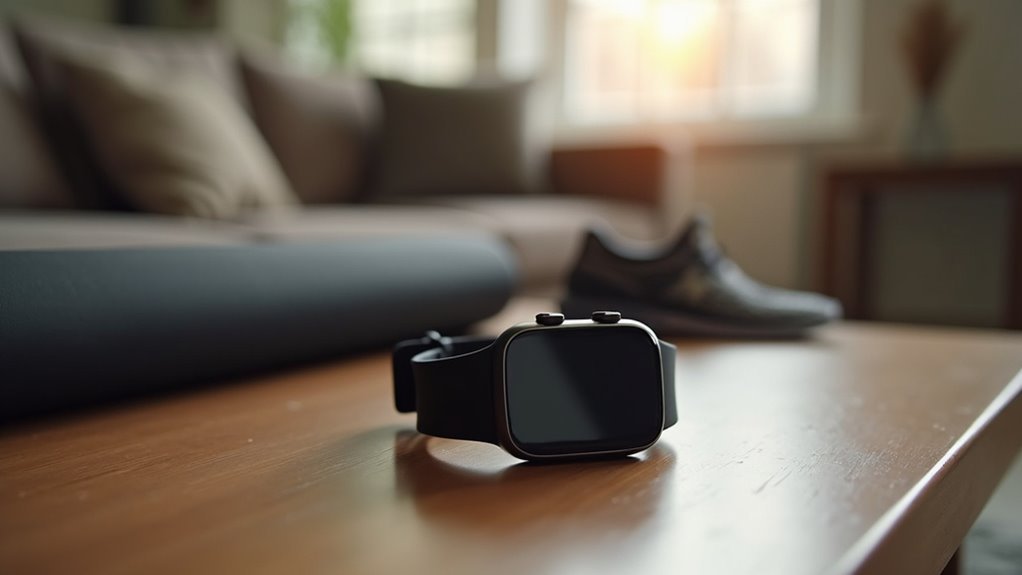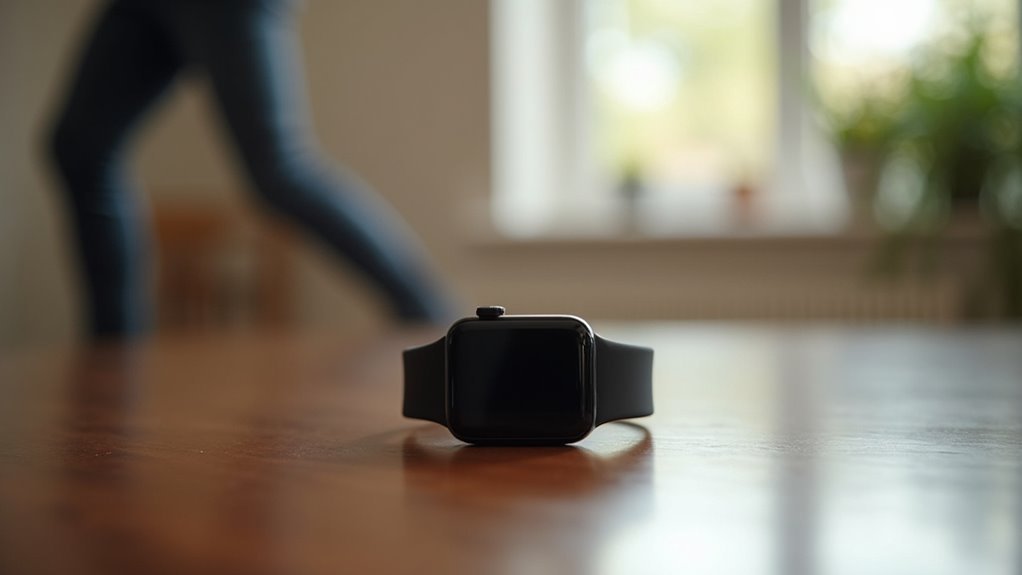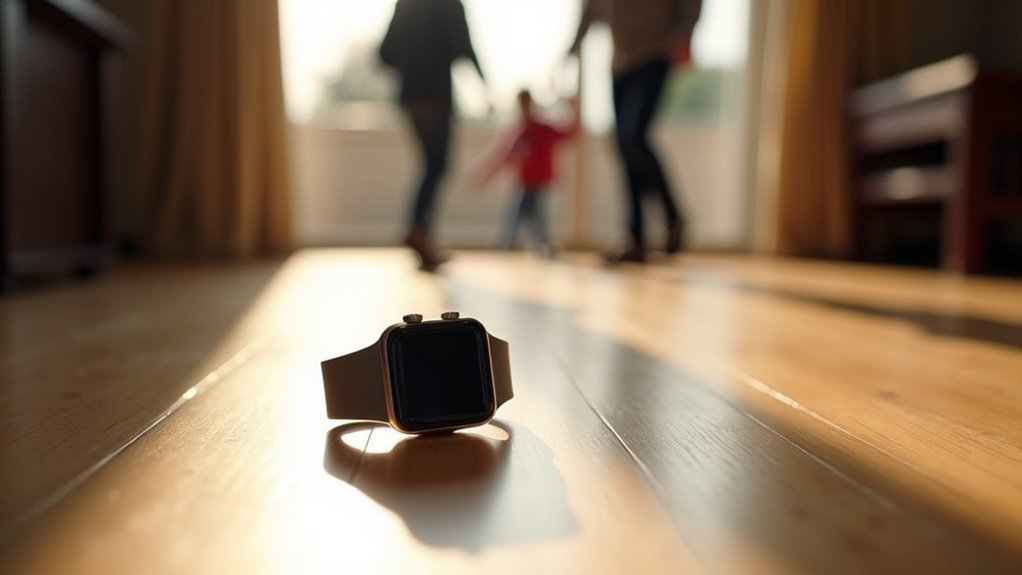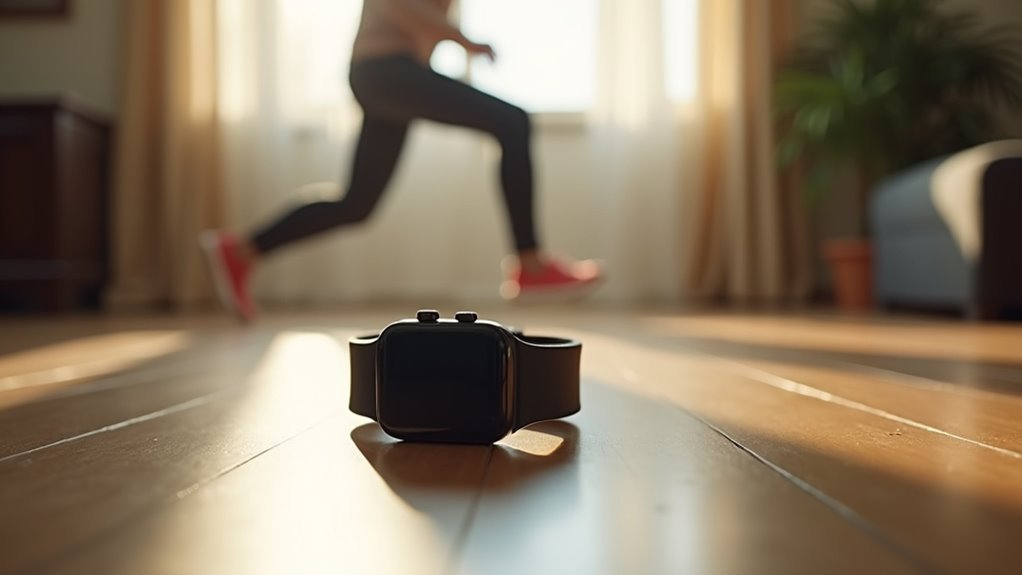When you fall while wearing a modern detection device, you’ll receive emergency help in as little as 28 seconds thanks to advanced sensors that instantly recognize the fall and automatically alert your emergency contacts or monitoring services. Professional systems can activate alerts within 1-2 seconds of detecting a fall, while wearable panic buttons deliver notifications almost immediately. GPS tracking guarantees responders locate you quickly, and machine learning algorithms minimize false alarms while maintaining accurate detection. Understanding these technologies reveals how strategic placement and optimization enhance your safety.
Technology Behind Instant Fall Recognition

Three core sensors work together to make your wearable device recognize when you’ve fallen. Accelerometers detect sudden changes in movement speed and direction, while gyroscopes measure your body’s rotation and orientation.
These sensors continuously capture movement data that’s essential for accurate fall detection. Your device processes this raw sensor data through sophisticated filtering methods that reduce noise and improve accuracy.
Raw sensor data undergoes sophisticated filtering to eliminate noise, ensuring your wearable device delivers the most accurate fall detection possible.
Advanced algorithms then analyze the cleaned data, extracting key features like spatiotemporal gait parameters and postural stability measurements. Modern systems use both conventional machine learning and deep learning approaches to distinguish between normal activities and actual falls. Optimal feature selection is crucial for developing efficient fall risk assessment tools that enhance prediction accuracy.
Some cutting-edge devices now employ patch-transformer networks and explainable AI techniques, making fall detection decisions more accurate and transparent than ever before.
Motion Sensors and Machine Learning Detection Methods
When your wearable detects a fall, it’s the seamless integration of motion sensors and machine learning algorithms that makes split-second decisions possible. Your device’s inertial sensors continuously monitor acceleration, orientation, and movement patterns from strategic locations like your wrist or ankle.
These sensors analyze your gait patterns to assess fall risks before incidents occur.
Machine learning algorithms process this sensor data in real-time, identifying patterns that indicate actual falls versus normal activities. The algorithms learn from your specific behavior patterns, creating personalized detection profiles that improve accuracy over time.
This smart combination reduces false alarms while maintaining high detection rates.
Your wearable’s system reliability increases as the machine learning components refine their understanding of your unique movement signatures, ensuring you receive immediate alerts when genuine falls are detected. Advanced systems incorporate tri-axial accelerometers and gyroscopes to enhance detection precision and minimize incorrect alerts.
Emergency Alert Response Time Benchmarks

When you’re evaluating fall detection wearables, you’ll want to understand how quickly these devices can summon help during an emergency.
The fastest systems like HandsFree Health respond in just 28 seconds, while industry standards consider anything under 90 seconds acceptable for emergency dispatch. Professional systems can also achieve response times of 1 to 2 seconds for initial alert activation, demonstrating the critical importance of reliable emergency technology.
Your device’s alert delivery method—whether it’s instant notification to monitoring centers, direct emergency dispatch, or smartphone integration—directly impacts how quickly responders can reach you.
Industry Standard Timeframes
While traditional emergency calls average around 10 minutes for response in the U.S., wearable emergency alert systems can notify responders within seconds, fundamentally transforming intervention timelines.
You’ll find professionally monitored medical alert systems advertise response times as low as 29 seconds. School-based wearable devices trigger coordinated responses in under a minute when streamlined procedures are implemented.
You’re getting faster intervention because wearables bypass dialing delays through Bluetooth connectivity and provide instant GPS location accuracy. This guarantees responders reach the right place immediately. The multi-channel notification system sends simultaneous SMS texts, emails, and in-app alerts to enhance response efficiency.
Schools report complete response cycles from button press to dispatch within 1-2 minutes. The hands-free, single-touch operation works even during distress, while two-way audio lets responders assess situations before arrival.
These systems consistently outperform traditional call buttons and front-office notifications.
Fastest Detection Systems
Three industry leaders consistently deliver the fastest fall detection response times, with HandsFree Health setting the benchmark at just 28 seconds from detection to alert delivery.
You’ll find Medical Guardian’s MG Move and Mini Lite systems averaging 52 seconds, still well within the 90-second industry standard requiring detection of at least two out of three falls.
These fastest systems achieve their speed through wearable sensors combining accelerometers, gyroscopes, and GPS for real-time monitoring.
You’re getting data transmitted asynchronously and processed through classification models for rapid event identification.
Edge computing reduces latency between detection and alert transmission, while cloud platform integration guarantees robust emergency alert delivery. While these systems offer impressive speed, no fall detection technology achieves 100% accuracy, with real-world testing showing potential for false alarms that users should anticipate.
Future systems you’ll see aim for sub-30 second response times as standard across all price points, driven by advancing sensor technology.
Alert Delivery Methods
Multiple alert delivery methods work together to guarantee you receive emergency assistance when seconds count.
Your wearable panic button delivers immediate incident notifications, alerting emergency services within 1 to 2 seconds of activation. Real-time GPS tracking pinpoints your exact location, helping responders find you quickly during emergencies.
You’ll receive vibrations and feedback confirming your alert’s been sent successfully. Private dispatch centers, like those used by Rescu systems, process your emergency signal and coordinate help immediately.
Whether you’re wearing a smartwatch or dedicated medical alert device, you can activate assistance through panic buttons or voice commands. Smart devices are increasingly equipped with health-monitoring features that can detect irregularities and prompt necessary medical attention.
Fall detection works automatically, triggering alerts even when you can’t manually activate help. This multi-layered approach assures you’re never alone during emergencies.
Real-World Accuracy and Performance Statistics

When evaluating fall detection wearables in real-world conditions, you’ll find that accuracy rates typically range from 93% to 98%, with device placement playing a crucial role in performance outcomes.
Chest-mounted devices achieve the highest accuracy at 98%, while studies using advanced CNN algorithms have demonstrated accuracy rates up to 98.97%.
However, you’ll encounter notable challenges with false alarms. Some studies report concerning statistics where 83 of 84 alarms were false positives, potentially causing user anxiety and system distrust.
Key performance factors you should consider:
- Device placement – chest positioning delivers ideal accuracy
- Algorithm sophistication – CNNs greatly improve detection rates
- Testing standardization – variability between studies highlights inconsistent methodologies
- Real-world data collection – obtaining thorough fall data remains logistically challenging for manufacturers
The technology focuses on assisting seniors who live alone and may be unable to seek help after experiencing a fall-related incident.
Critical Features That Accelerate Emergency Notifications
When you’re facing a fall emergency, three critical features determine how quickly help reaches you.
Your device’s GPS location accuracy guarantees responders know exactly where to find you, while instant data processing triggers alerts within seconds of impact detection.
Multiple alert channels simultaneously notify emergency services, family members, and monitoring centers, creating redundant pathways that won’t leave you waiting for assistance. These devices maintain extensive range capabilities to effectively detect falls whether you’re inside your home or in outdoor environments.
GPS Location Accuracy
GPS accuracy stands as the cornerstone of effective emergency response, transforming how quickly help reaches you during a fall or medical crisis. When you’re unable to communicate your location, precise GPS coordinates become your lifeline, directing responders to your exact position within minutes.
Modern wearables deliver exceptional location precision through:
- Real-time coordinate transmission to monitoring centers and emergency services
- Continuous tracking capabilities that work even when you’re moving or outdoors
- Integration with mobile connectivity for enhanced reliability and faster alerts
- Automatic location sharing with trusted contacts and professional responders simultaneously
The stakes couldn’t be higher when considering that survival chances decrease 10% per minute during cardiac arrest situations, making GPS precision a critical factor in life-or-death scenarios.
This accuracy proves invaluable whether you’re a senior living independently, a mobile worker in unfamiliar territory, or anyone facing a medical emergency where every second counts toward receiving appropriate care.
Instant Data Processing
Behind every life-saving alert lies a sophisticated network of instant data processing that transforms raw sensor information into emergency notifications within seconds.
Your wearable’s advanced sensors, including IMU and Bluetooth components, continuously capture movement data while AI-powered algorithms analyze sudden posture changes and impact patterns in real-time.
Edge computing processes this data directly on your device, eliminating delays from cloud transfers.
Machine learning integration helps your wearable distinguish between actual falls and normal movements, reducing false alarms.
When a fall’s detected, sensor fusion combines multiple data streams for accuracy verification.
Your device’s automatic alert systems immediately activate emergency protocols, sending notifications to designated contacts.
This local processing guarantees data privacy while maintaining lightning-fast response times that could save your life. These systems demonstrate the benefits of interdisciplinary collaboration where engineering, healthcare, and AI expertise converge to enhance elderly safety outcomes.
Multiple Alert Channels
Fast processing means nothing if your emergency alert can’t reach the right people through the right channels.
Modern wearables create redundant communication pathways that guarantee your fall alert reaches help, regardless of circumstances.
Your device doesn’t rely on a single alert method. Instead, it activates multiple channels simultaneously:
- Automatic GPS notifications sent to emergency contacts with your precise location
- Two-way voice communication enabling direct contact with safety personnel
- Centralized monitoring systems that coordinate professional emergency response
- Escalating alert protocols that contact higher authorities if initial responses fail
This multi-channel approach dramatically reduces response times while minimizing the risk of missed alerts. These systems provide continuous documentation that helps organizations maintain OSHA compliance for worker safety monitoring requirements.
Whether you’re unconscious or unable to communicate, these redundant systems guarantee someone receives your emergency notification and can dispatch appropriate help immediately.
GPS Integration and Location-Based Alert Systems
When you’re wearing a fall detection device, the integration of GPS technology transforms a simple alert into a potentially life-saving response system. Your device provides precise location data to emergency responders, dramatically reducing response times.
You’ll find GPS particularly effective outdoors, while indoor tracking relies on Wi-Fi or Bluetooth technologies.
Location-based alert systems automatically notify your designated contacts or emergency services when a fall’s detected. You can customize alert protocols based on your location—whether you’re at home or outdoors.
The integration of GPS with accelerometers, gyroscopes, and barometers helps reduce false alarms by better distinguishing actual falls from everyday movements. This combination guarantees help reaches the correct location quickly, with some devices achieving response times as fast as 28 seconds. Many wearable devices utilize Bluetooth technology to enhance connectivity and ensure reliable communication with monitoring systems.
Battery Life Impact on Continuous Monitoring
Battery life fundamentally determines whether your wearable device can deliver the continuous monitoring that makes fall detection effective.
Without dependable battery power, sophisticated fall detection algorithms fail precisely when older adults face their greatest vulnerability and need immediate assistance.
Without reliable power, even the most advanced fall detection algorithms become useless during critical moments when you need help most.
Your device’s battery performance directly impacts your safety through several key factors:
- Uninterrupted Protection – Continuous monitoring guarantees falls are detected instantly without gaps in coverage.
- Reduced Charging Anxiety – Longer battery life means you won’t worry about your device dying unexpectedly.
- Enhanced System Reliability – Consistent power maintains all safety features, including GPS tracking and emergency alerts.
- Improved User Compliance – You’re more likely to wear devices that don’t require frequent charging.
Purpose-built medical alert systems provide more accurate fall detection than consumer smartwatches when maintained with adequate battery power.
Choosing wearables with extended battery life guarantees your fall detection system remains active when you need it most.
Overcoming False Alarms and System Reliability Challenges
Although fall detection technology has advanced considerably, false alarms remain one of the most persistent challenges you’ll face with wearable safety devices.
You’ll encounter false alarm rates as low as 0.025 per hour, meaning one false alarm every 40 hours after system adjustments. These false alarms can desensitize your caregivers and waste emergency response efforts.
You can improve reliability through strategic sensor placement. Devices positioned on your trunk, foot, or leg deliver better accuracy than other locations.
However, you’ll notice significant accuracy variations between different devices, ranging from 73% to 98%. Your movement patterns and device comfort directly affect system performance.
Continuous algorithm optimization and proper data analysis help minimize false alarms while maintaining detection sensitivity for real emergencies. Real-world testing shows that accelerometry-based systems can achieve 80% sensitivity in detecting actual falls among older adults.
Frequently Asked Questions
Can Wearable Fall Detection Devices Work Without a Smartphone or Internet Connection?
Yes, you’ll find many wearable fall detection devices work independently using built-in cellular connectivity and GPS. They’ll detect falls through sensors and send alerts directly to emergency contacts without needing smartphones or internet.
What Happens if the Wearable Device Breaks During a Fall Impact?
If your wearable device breaks during fall impact, it can’t send emergency alerts, leaving you without immediate help. This delayed response increases injury severity and undermines your confidence in the device’s reliability.
Do These Devices Work for Wheelchair Users or People With Mobility Aids?
Most wearable devices work for wheelchair users, but you’ll need customization for your specific mobility needs. You can adjust contact settings and disable false alarms that commonly trigger during wheelchair transfers.
Can Family Members Customize Who Gets Notified During Different Times of Day?
You can customize notification recipients by time of day on advanced fall alert devices. You’re able to designate different family members for daytime versus nighttime alerts, ensuring appropriate contacts receive notifications.
Are There Monthly Subscription Fees Required for the Emergency Alert Services?
Yes, you’ll pay monthly subscription fees for emergency alert services. Costs range from $19 to over $100 monthly, depending on features you choose. Some providers also charge activation fees.
In Summary
You’ll find that modern wearables can detect falls within seconds and alert emergency contacts in under 60 seconds when you’re wearing them properly. You can’t rely on 100% accuracy, but today’s devices achieve 85-95% detection rates when you’ve configured them correctly. You’ll get the fastest response times when you’ve enabled GPS, maintained battery life above 20%, and customized your emergency contact list. Don’t ignore system updates—they’ll improve your device’s reliability.





Leave a Reply